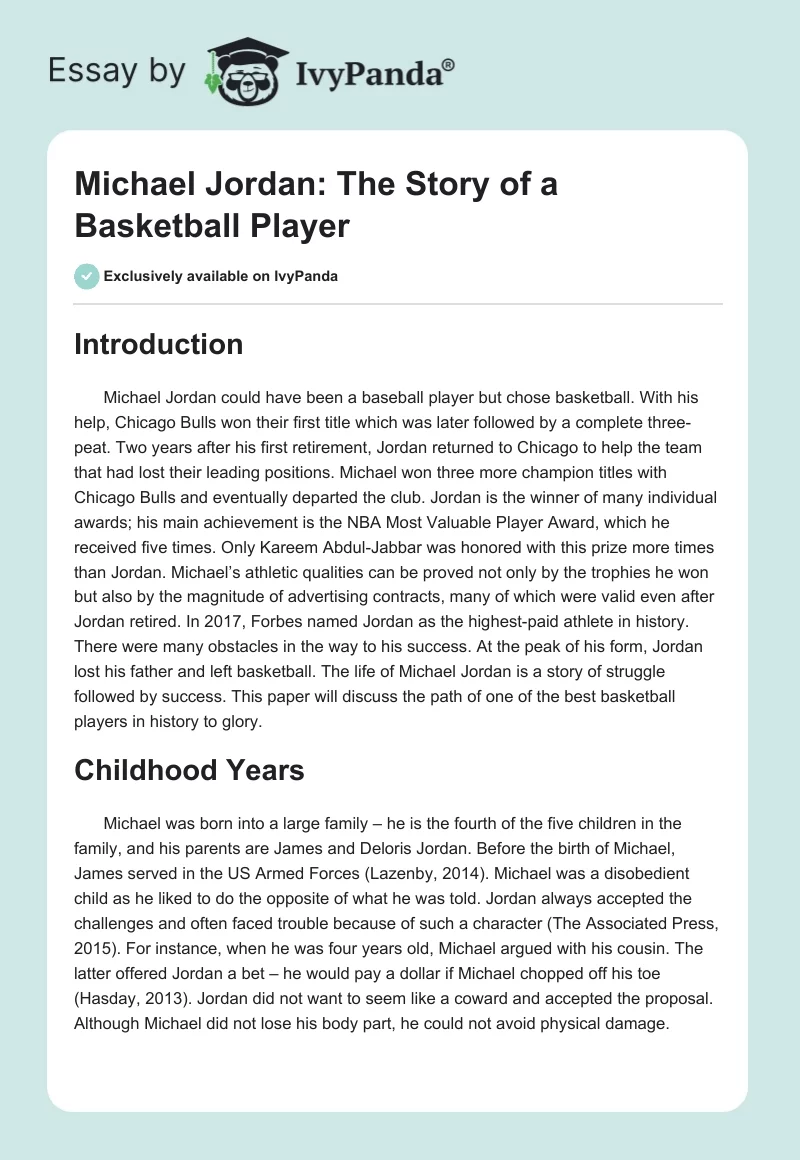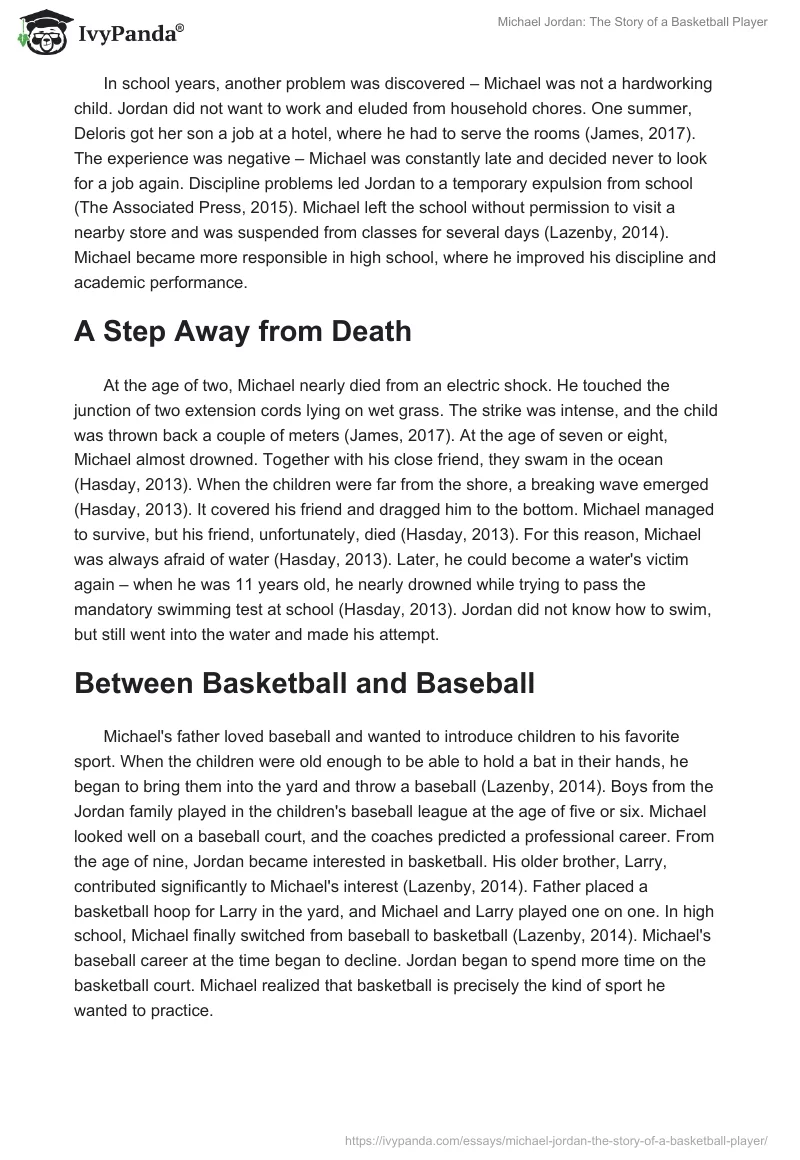Introduction
Michael Jordan could have been a baseball player but chose basketball. With his help, Chicago Bulls won their first title which was later followed by a complete three-peat. Two years after his first retirement, Jordan returned to Chicago to help the team that had lost their leading positions. Michael won three more champion titles with Chicago Bulls and eventually departed the club. Jordan is the winner of many individual awards; his main achievement is the NBA Most Valuable Player Award, which he received five times. Only Kareem Abdul-Jabbar was honored with this prize more times than Jordan.
Michael’s athletic qualities can be proved not only by the trophies he won but also by the magnitude of advertising contracts, many of which were valid even after Jordan retired. In 2017, Forbes named Jordan as the highest-paid athlete in history. There were many obstacles in the way to his success. At the peak of his form, Jordan lost his father and left basketball. The life of Michael Jordan is a story of struggle followed by success. This paper will discuss the path of one of the best basketball players in history to glory.
Childhood Years
Michael was born into a large family – he is the fourth of the five children in the family, and his parents are James and Deloris Jordan. Before the birth of Michael, James served in the US Armed Forces (Lazenby, 2014). Michael was a disobedient child as he liked to do the opposite of what he was told.
Jordan always accepted the challenges and often faced trouble because of such a character (The Associated Press, 2015). For instance, when he was four years old, Michael argued with his cousin. The latter offered Jordan a bet – he would pay a dollar if Michael chopped off his toe (Hasday, 2013). Jordan did not want to seem like a coward and accepted the proposal. Although Michael did not lose his body parts, he could not avoid physical damage.
In school years, another problem was discovered – Michael was not a hardworking child. Jordan did not want to work and eluded from household chores. One summer, Deloris got her son a job at a hotel, where he had to serve the rooms (James, 2017). The experience was negative – Michael was constantly late and decided never to look for a job again.
Discipline problems led Jordan to a temporary expulsion from school (The Associated Press, 2015). Michael left the school without permission to visit a nearby store and was suspended from classes for several days (Lazenby, 2014). Michael became more responsible in high school, where he improved his discipline and academic performance.
A Step Away From Death
At the age of two, Michael nearly died from an electric shock. He touched the junction of two extension cords lying on wet grass. The strike was intense, and the child was thrown back a couple of meters (James, 2017). At the age of seven or eight, Michael almost drowned. Together with his close friend, they swam in the ocean (Hasday, 2013). When the children were far from the shore, a breaking wave emerged (Hasday, 2013). It covered his friend and dragged him to the bottom.
Michael managed to survive, but his friend, unfortunately, died (Hasday, 2013). For this reason, Michael was always afraid of water (Hasday, 2013). Later, he could become a water’s victim again – when he was 11 years old, he nearly drowned while trying to pass the mandatory swimming test at school (Hasday, 2013). Jordan did not know how to swim, but still went into the water and made his attempt.
Between Basketball and Baseball
Michael’s father loved baseball and wanted to introduce children to his favorite sport. When the children were old enough to be able to hold a bat in their hands, he began to bring them into the yard and throw a baseball (Lazenby, 2014). Boys from the Jordan family played in the children’s baseball league at the age of five or six. Michael looked well on a baseball court, and the coaches predicted a professional career.
From the age of nine, Jordan became interested in basketball. His older brother, Larry, contributed significantly to Michael’s interest (Lazenby, 2014). Father placed a basketball hoop for Larry in the yard, and Michael and Larry played one on one. In high school, Michael finally switched from baseball to basketball (Lazenby, 2014). Michael’s baseball career at the time began to decline. Jordan began to spend more time on the basketball court. Michael realized that basketball is precisely the kind of sport he wanted to practice.
Beginning of the Brightest Career
There were no tall people in the Jordan family, and Michael was no exception. Short stature substantially interfered with Jordan – when Michael was 15 years old, he was not accepted into the high school basketball team due to his height (The Associated Press, 2015).
In the eleventh grade, the grown-up Michael was eventually taken to the basketball team (James, 2017). There he was noticed by an assistant coach of the Tar Heels team of the University of North Carolina. The specialist immediately appreciated the talent of the young player (James, 2017). During his time at the university, Michael grew even more (The Associated Press, 2015). When Jordan began to play in the NBA, his height was 198 cm.
In Jordan’s first game for the Tar Heels team at the University of North Carolina, his team beat Kansas with a score of 74:67, where Michael brought his team 12 points (Basketball Reference, 2020). Besides this first match, the whole season can be considered successful. Tar Heels reached the finals, where they beat Georgetown with a score of 63:62. Jordan’s toss into the final 15 seconds of the game brought the team victory in the game and the season (Basketball Reference, 2020).
Chicago Bulls
Before Jordan came to Chicago Bulls in 1984, the team was without champion ambitions. With the arrival of Michael, the new owner and the new management came (The Associated Press, 2015). The idea was to build a new team around Jordan, and this plan was successful (The Associated Press, 2015). Michael quickly became the star of the Chicago Bulls.
In the first season in the NBA, Michael averaged 28.2 points per game in the regular season and 29.2 in the playoffs (Basketball Reference, 2020). These were the best indicators in the team, and in 1985, Michael received the Rookie of the Year Award (The Associated Press, 2015). Jordan could be distinguished from the crowd of other basketball players by his trademark jump. He seemed to hang in the air for a few seconds and earned the nickname Air Jordan and His Airness (The Associated Press, 2015). Michael’s nickname was quickly monetized – in 1984, Jordan entered into an advertising contract with Nike.
Jordan won his first NBA title in 1991 and managed to win the league for three consecutive years – 1991, 1992, and 1993. After his father’s murder in 1994, however, Jordan decided to retire from basketball (The Associated Press, 2015). With Michael’s departure, Chicago Bulls could not achieve any success. In 1995, Jordan decided to return to basketball, but the season was almost over, so he could not make any significant contributions to Chicago Bulls’ performance (The Associated Press, 2015).
A year later, however, Michael helped his team start their path to the second three-peat. Chicago Bulls became champions in 1996, 1997, and 1998, and Jordan’s participation in this three-year success is colossal (The Associated Press, 2015). He retired for the second time in 1999, and although he came back two years later to play for Washington Wizards, he could not manage to win another title. In 2003, Jordan ended his basketball career for the last time.
Conclusion
The story of Jordan is full of effort, determination, and success. Despite facing many obstacles in his life, Jordan managed to become one of the greatest basketball players of all time. In his youth, Michael was short and could not qualify for school basketball teams. Several times, Michael almost faced a tragic ending – in childhood, he nearly drowned twice. However, Jordan always persevered, and his persistence granted him and Chicago Bulls two three-peats. He is one of the best players in the history of both the Chicago Bulls and basketball in general.
References
Basketball Reference. (2020). Michael Jordan stats. Basketball Reference.
Hasday, J. (2013). Michael Jordan (Modern role model). Mason Crest.
James, S. (2017). Michael Jordan: A unique insight into the career and mindset of Michael Jordan. CreateSpace.
Lazenby, R. (2014). Michael Jordan: The life. Little, Brown and Company.
The Associated Press. (2015). Michael Jordan: Beyond the court. Mango Media.


